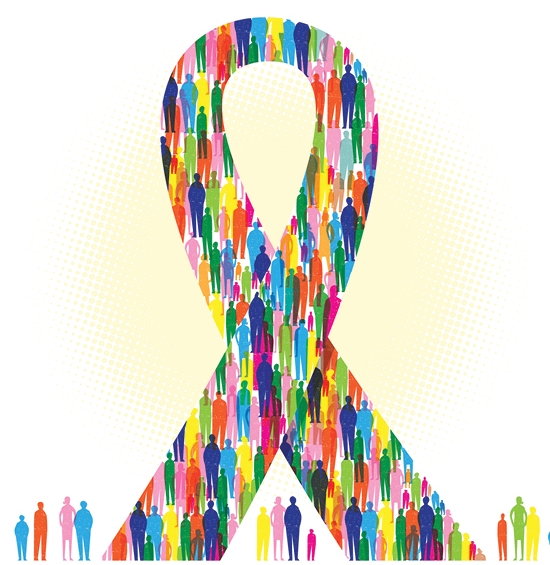Going Glocal: Cancer
By Martha McKenzie, Illustrations by Mike Austin


It’s not black and white
Delving into puzzling breast cancer mortality disparities
Breast cancer strikes black and white women at equal rates, but black women are 40 percent more likely to die from it. That dismal fact has long been known. The mystery is why.
|
|
Lauren McCullough wants to know why black women die from breast cancer more often than white women. |
Dr. Lauren McCullough believes she is perfectly situated to find the answer. For one thing, she’s in metro Atlanta, where African Americans make up 30 percent of the population. For another, she’s at Rollins, home of the Georgia Center for Cancer Statistics, which collects information on each new cancer diagnosis within the state.
McCullough, assistant professor of epidemiology, and her team are scouring the vast registry, looking at the characteristics of tumor, treatment, and patient to see if variations can account for the higher mortality rate in black women. It’s early in the investigation, but she has already been surprised by what she’s found.
One type of breast cancer, triple-negative, typically strikes younger women and spreads more aggressively than other types. Though relatively rare, triple negative cancer occurs in black women more frequently than white women. Researchers have focused on this type of cancer when trying to understand mortality disparities.
However, McCullough and her team have found the real difference occurs with the more common, less aggressive ER-positive breast cancers. “In metro Atlanta, black women with triple negative breast cancer are approximately 35 percent more likely to die compared with white counterparts,” she says. “Yet black women with ER-positive breast cancer have a more than 2.5-fold increased risk of death compared with white women.
“This was totally unexpected,” continues McCullough. “ER-positive tumors account for about 75 percent of breast cancer. They are often caught early through screening. We know how they grow and progress. We have targeted therapies that treat this type of cancer really well. So why are black women dying of this very treatable cancer?”
Even more surprising, mortality disparities rise with income—the difference in mortality rates between affluent black and affluent white women is greater than the difference in lower income black and lower income white women.
“Presumably, these women have equal access to care, have insurance, have support systems,“ says McCullough. “It’s very perplexing.”
So the team is mining the registry database again to search for answers. Perhaps there are some biological differences even within ER-positive tumors of black versus white women. Maybe black women are less likely to receive guideline-concordant care or adhere to endocrine therapy. Maybe they are operating in a higher stress environment.
“A lot of attention has been focused on finding ways to treat triple negative tumors,” says McCullough. “Our findings suggest we could make a lot more progress by figuring out why disparities exist in tumors for which there are established therapies. That’s where we are going to be digging deeper.”


Predicting cancer recurrence
Using rich Danish registry to look for clues
Colorectal cancer is the third most common cancer in the world, with more than 1.8 million new cases in 2018. Many survivors are at risk of dying from a recurrence of the cancer, most commonly in the first few years after diagnosis. Dr. Veronika Fedirko is using a wealth of high-quality nationwide data in Danish medical, clinical, and population registries to find clues that could be used to predict colon cancer recurrence.
|
|
Veronika Fedirko thinks the gut microbiome may hold the key to predicting colon cancer recurrence. |
Currently, there are no definitive biomarkers to identify colon cancer with a high likelihood to recur. Treatment decisions are based largely on the size and grade of the tumor, not on tumor risk profiles. As a result, patients with relatively small but more aggressive tumors could be undertreated, and patients with larger but less aggressive tumors could be overtreated, according to Fedirko, assistant professor of epidemiology. That could translate into some patients suffering the debilitating side effects of cancer therapies unnecessarily and others not getting the treatment they need to prevent recurrence.
To find biomarkers of recurrence, Fedirko is working with cohorts in Denmark who have been collecting colon tumor samples for several years and following the patients from whom the samples were collected. They are analyzing the gut microbiome composition in the samples to see if different bacteria correlate with cancer recurrence.
To validate the findings in the Denmark cohorts, Fedirko is duplicating the study at Emory, recruiting at least 200 colon cancer patients with stage II and III tumors, analyzing the bacterial composition of the tumors, and following the patients for recurrence. Her team is also taking blood samples and asking participants questions about lifestyle, medications, and diet.
“We know colorectal cancer is related to Westernized lifestyle, driven by diet and low physical activity level,” says Fedirko. “Emerging basic science and animal evidence suggests that the gut microbiome, which could be modified by diet, plays an important role in colorectal cancer development and progression. That made me think differences in the gut microbiome would be a good place to look for biomarkers.”
In parallel to biomarker studies, Fedirko is looking at whether use of antibiotics or gastric acid reducers (proton-pump inhibitors or PPIs) increase the risk of colorectal cancer recurrence. Studies have shown that these drugs alter the composition and diversity of the gut microbiome. These two types of medications are also widely overused. Taking advantage of high-quality data in Danish registries, Fedirko and her collaborators at Aarhus University Hospital are analyzing colorectal cancer patients’ data to see whether antibiotic or PPI use before their diagnosis is associated with higher risk for cancer recurrence.



